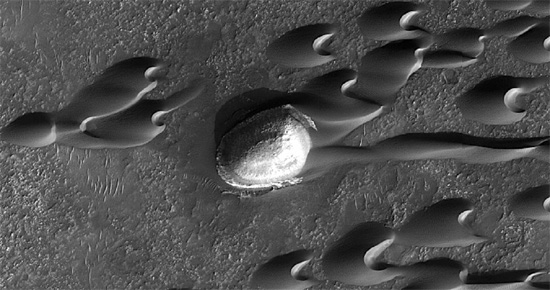|

An
image of Mars from the HiRise
camera. Credit: NASA/JPL/University
of Arizona
MRO's Fifth Year
Mar 11, 2011
Cameras orbiting Mars continue
to provide spectacular imagery that
helps confirm Electric Universe
theories.
On August 12, 2005
NASA launched the Mars
Reconnaissance Orbiter (MRO) on a
two year mission to map the surface
of the Red Planet. After several
months of flight, polar orbit
insertion occurred on March 10,
2006. However, more months of
aerobrakingódipping in and out of
the Martian atmosphere in order to
reduce speedówere required, as well
as thruster burns needed to
circularize its orbit. Final orbital
parameters were achieved in
September 2006.
Its other primary science goal
was and continues to be a search for
water in the barren wastelands of
Mars, as well as to identify landing
sites for future robotic explorers.
After completion of its original
mission, MRO was funded twice more,
with another two years to go.
Several
scientific instruments
are onboard the spacecraft. Among
them are a spectrometer, radar, and
a gravity field detector, as well as
several cameras assigned to various
tasks. In particular, the High
Resolution Imaging Science
Experiment camera (HiRise), a 0.5
meter telescope, able to resolve
objects as small as 30 centimeters
from 300 kilometers up, has provided
Electric Universe advocates
uncountable examples of
past, intense
electrical activity on
Mars.
The equatorial diameter of Mars
is approximately 6793 kilometers,
about half that of Earth. Its
average temperature is - 63 Celsius,
compared to Earth at 13 Celsius. The
atmospheric density on Mars is
equivalent to standing on top of a
mountain six times taller than Mount
Everest, or 1/800 that of Earth at
sea level.
Scientists speculate that four
billion years ago, Mars lost most of
its atmosphere. How is not known,
but several theories have been put
forward. An asteroid impact might
have exploded with such force that
it blew the atmosphere away. A
torrent of charged particles blazing
out from the Sun could have eaten
away the atmosphere over millions of
years, leaving Mars as it is today.
Martian areography tells
a story of incredibly violent
events. It appears from the
many images sent to Earth
by MRO's HiRise camera that it once
experienced powerful plasma
discharges on a massive scale. As
terrain mapping instruments
indicate, the northern latitudes of
Mars are six kilometers below the
mean elevation of the planet.
Burned and blasted
craters,
piles of scorched dust
covering almost an entire
hemisphere, and
great trenches that wend
across its scarred face lead to the
conclusion that lightning thousands
or millions of times more energetic
than we know today devastated Mars.
The existence of these formations
constitutes a confirmation of the
Electric Universe hypothesis.
On Mars, deep channels,
ripples and other
structures are thought to be the
remains of water flowing on the
surface, eroding it in the same way
as water is believed to erode our
planet. It has been proposed that
there were oceans of water millions
of years ago, so chemicals that form
on Earth in the presence of water
are presumed to have formed on Mars
in the same fashion. Despite the
contradictory evidence of mineral
deposits that would be destroyed by
water, such as olivine,
the flowing water hypothesis
continues to guide consensus
theories.
It has been suggested
many times in these pages
that electric arcs could have
sculpted what we see on Mars.
Valles Marineris,
Olympus Mons, the vast
900 kilometer crater in
Argyre Planitia, the
terraced mounds in
Arabia Terra, as well as
both Martian poles demonstrate
strong support for the electric
discharge theory.
NASA scientists often refer to
what they find on Mars as
"mysterious" or "puzzling" with long
years of research and contemplation
ahead of them. We predict that the
reason for the confusion is the
problem of reverse application.
Earth should not be used to explain
the Solar System. The geological
patterns found elsewhere deserve
alternative viewpoints.
Stephen Smith
Multimedia

The Lightning-Scarred Planet Mars
Symbols of an Alien Sky
DVD episode 2
A video documentary that could change everything you thought you knew
about ancient times and symbols.
The Symbols of an Alien Sky video series will introduce you to celestial
spectacles and earth-shaking events once remembered around the world.
Archaic symbols of these events still surround us, some as icons of the
worldís great religions, though the origins of the symbols appear to be
lost in
obscurity.
In this second episode of Symbols of an Alien Sky, David
Talbott takes the viewer on an odyssey across the surface of Mars.
Exploring feature after feature of the planet, he finds that only
electric arcs could produce the observed patterns. The high resolution
images reveal massive channels and gouges, great mounds, and crater
chains, none finding an explanation in traditional geology, but all
matching the scars from electric discharge experiments in the
laboratory.
(Approximately 85 minutes) See:
Lightning-Scarred
Planet info
|








